
Last modified: 16 October 2019
Translation of original French
| Author: | Talla Takam et al., in preparation |
| Age: | Archean |
| Reference section: | Reference outcrop 18-LP-6158 |
| Type area: | NTS sheets 33A07 to 33A10 and 23D12 |
| Geological province: | Superior Province |
| Geological subdivision: | Opatica Subprovince |
| Lithology: | Tonalitic, dioritic and granulitic gneiss, tonalite, granodiorite and diorite |
| Type: | Lithodemic |
| Rank: | Complex |
| Status: | Formal |
| Use: | Active |
None
Background
The Misasque River massif was identified by Hocq (1985). He defined this unit as a heterogeneous band of intrusive rocks, leucotonalitic to granitic, located between Neptune and Fire lakes up to Léran Lake. The area occupied by the Misasque River massif was approximately 1500 km2. Following geological mapping work in the summer of 2016, Talla Takam et al. (in preparation) divided the Misasque River massif into different plutons based on their mineral composition, geochemistry and magnetic signature. The Misasque Pluton thus redefined mostly includes gneiss and intrusions of tonalite, granite and diorite located north of the René Group. Following mapping work in the summer of 2018, the Misasque Pluton became the Misasque Complex due to the varied nature and ages of rocks included in the unit (Beauchamp et al., 2019).
Description
The Misasque Complex is introduced to describe a large, polyphase gneissic and intrusive mass, bounded to the north by the Laguiche Complex and to the south by the Digne Pluton. This unit represents one of the oldest units in the Cadieux Lake and Bohier Island areas. It consists of the Mesoarchean to Neoarchean basement on which the Upper Eastmain Greenstone Belt (UEGB) has been emplaced. The Misasque Complex corresponds to a “TTG”-type (tonalite-trondhjemite-granodiorite) Archean continental crust. On the total magnetic field map, the Misasque Complex is characterized by uniform and moderate magnetic susceptibility. Only NNE-SSW and E-W oriented brittle fractures form straight lines that demagnetize the complex.
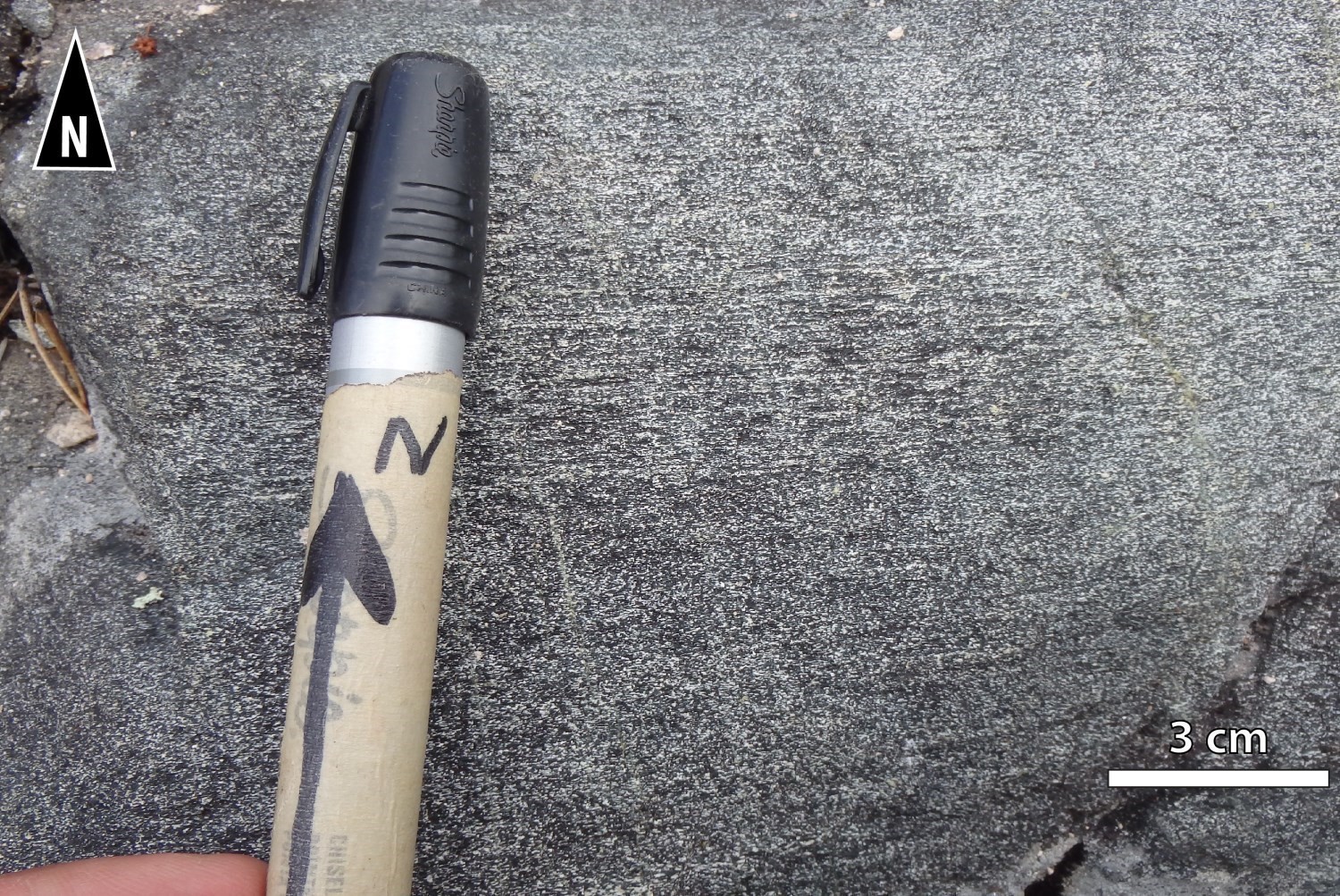 At least four (4) lithofacies have been recognized in the Misasque Complex: 1) variously migmatized tonalitic, dioritic and granitic gneiss, 2) homogeneous and foliated tonalite, 3) heterogeneous and foliated granite and granodiorite, and 4) massive to weakly foliated homogeneous granite. Rocks of the Misasque Complex are granoblastic and usually cut by several granitic phases occurring as multiple injections cutting or conformable to gneissosity. These intrusions are an integral part of the complex. Rocks of the Misasque Complex contain decimetric to decametric horizons and enclaves of intrusive rock (diorite, gabbro, amphibolite, quartz diorite, tonalite, very locally paragneiss and pyroxenite) representing 1% to 25% of outcropping surfaces. The most common enclaves are dioritic and gabbroic. They have a black and white spotted alteration patina. Enclaves are amphibolitized, foliated and highly granoblastic. They are characterized by well-developed L-S deformation.
At least four (4) lithofacies have been recognized in the Misasque Complex: 1) variously migmatized tonalitic, dioritic and granitic gneiss, 2) homogeneous and foliated tonalite, 3) heterogeneous and foliated granite and granodiorite, and 4) massive to weakly foliated homogeneous granite. Rocks of the Misasque Complex are granoblastic and usually cut by several granitic phases occurring as multiple injections cutting or conformable to gneissosity. These intrusions are an integral part of the complex. Rocks of the Misasque Complex contain decimetric to decametric horizons and enclaves of intrusive rock (diorite, gabbro, amphibolite, quartz diorite, tonalite, very locally paragneiss and pyroxenite) representing 1% to 25% of outcropping surfaces. The most common enclaves are dioritic and gabbroic. They have a black and white spotted alteration patina. Enclaves are amphibolitized, foliated and highly granoblastic. They are characterized by well-developed L-S deformation.
From a geochemical perspective (Beauchamp, 2019), rocks of the Misasque Complex are tonalite and type I metaluminous granite (Frost et al., 2001). Samples analyzed are enriched in light rare earths compared to heavy rare earths. Granite profiles are more evolved than those of tonalite and have an Eu negative anomaly (Palme and O’Neill, 2004). Spider diagrams of tonalite and granite exhibit negative anomalies in Nb-Ta, P, Ti and Sm, and enrichments in La-Ce and Zr-Hf (McDonough and Sun, 1995).
Because of the complexity and inconsistent distribution of lithological units, it was not possible to isolate them on the geological map. Lithofacies presented below are in order of importance.
Variously Migmatized Tonalitic, Dioritic and Granitic Gneiss
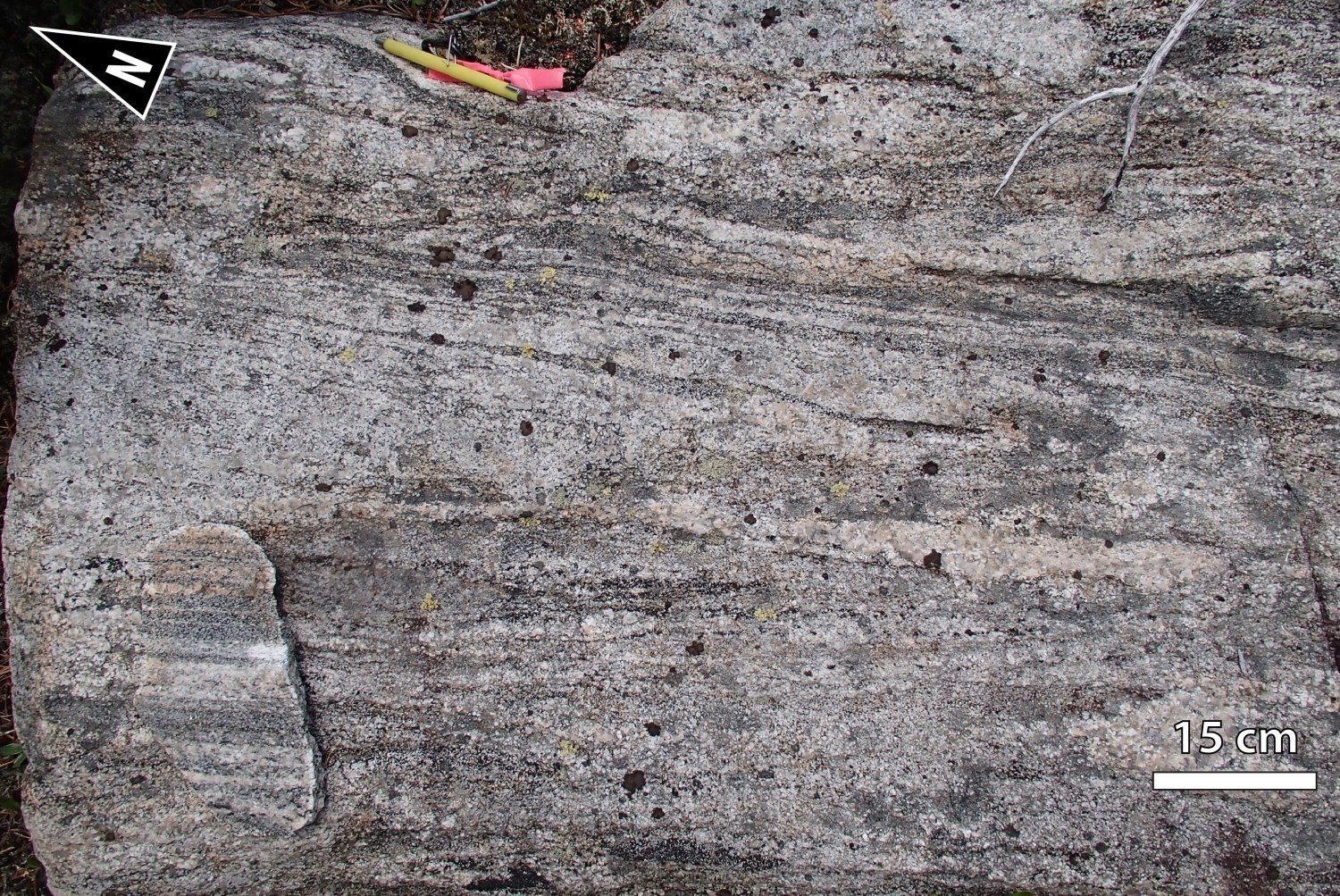
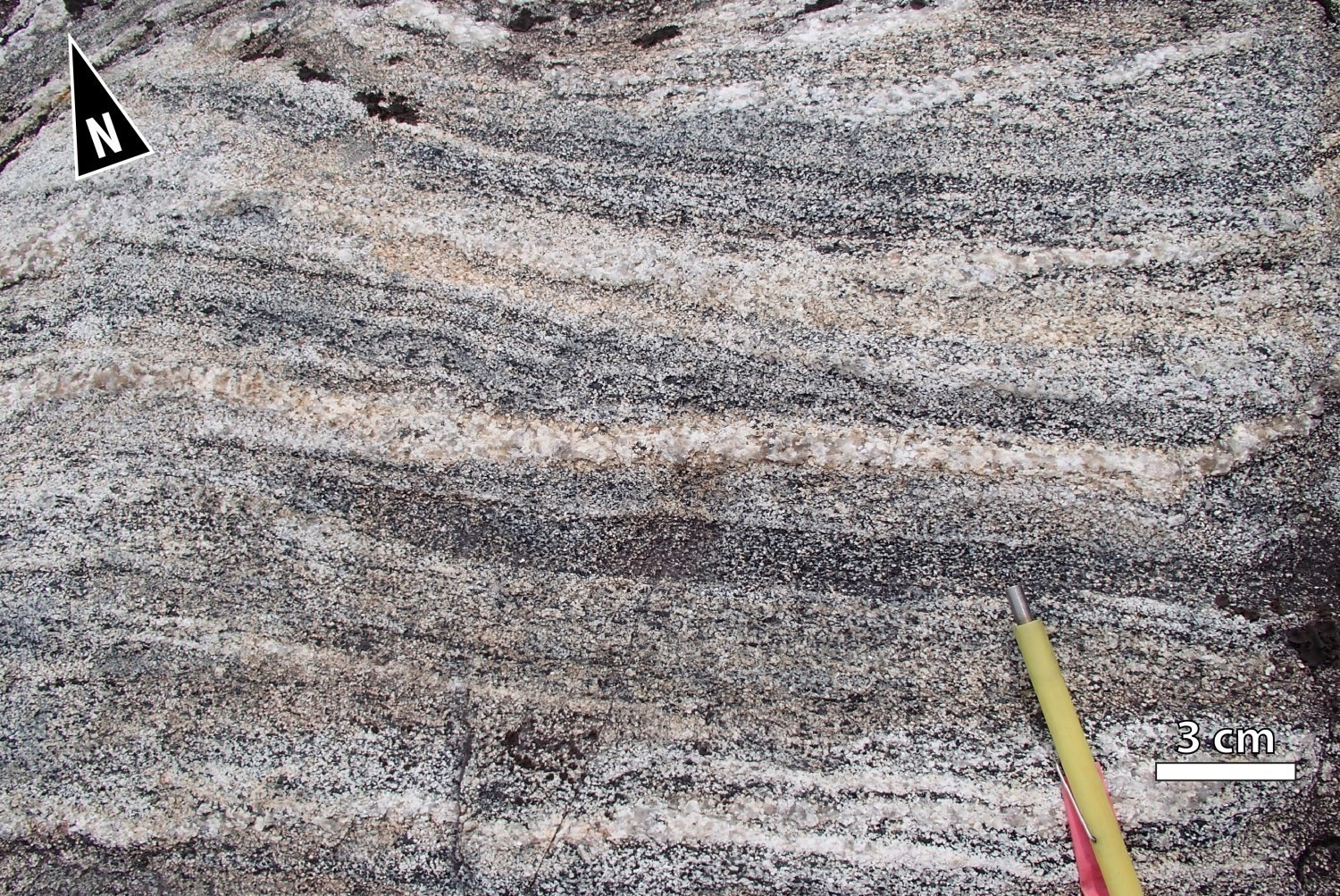 This orthogneiss unit consists of alternating millimetric to decimetric bands having composition varying from tonalitic to dioritic to granitic. In thin section, gneissosity occurs as alternating mafic bands (biotite ± hornblende ± magnetite) and whitish quartzofeldspathic layers. Sharp, irregular and very contrasting banding is accentuated by the presence of sub-conformable granitic injections. A large proportion of these rocks have undergone migmatization to varying degrees of partial melting, which is manifested by the presence of 5 to 70% granodioritic to granitic mobilisate. The mobilisate occurs as centimetric to decametric, discontinuous bands parallel or cutting regional foliation. Within the most migmatized rocks, intermediate to mafic enclaves float in the mobilisate. Hornblende porphyroblasts are distributed irregularly near intermediate rock enclaves. Centimetric amphiboles give the rock a speckled texture.
This orthogneiss unit consists of alternating millimetric to decimetric bands having composition varying from tonalitic to dioritic to granitic. In thin section, gneissosity occurs as alternating mafic bands (biotite ± hornblende ± magnetite) and whitish quartzofeldspathic layers. Sharp, irregular and very contrasting banding is accentuated by the presence of sub-conformable granitic injections. A large proportion of these rocks have undergone migmatization to varying degrees of partial melting, which is manifested by the presence of 5 to 70% granodioritic to granitic mobilisate. The mobilisate occurs as centimetric to decametric, discontinuous bands parallel or cutting regional foliation. Within the most migmatized rocks, intermediate to mafic enclaves float in the mobilisate. Hornblende porphyroblasts are distributed irregularly near intermediate rock enclaves. Centimetric amphiboles give the rock a speckled texture.
Orthogneiss contain biotite and magnetite, with varying amounts of green hornblende, chlorite and epidote. Ferromagnesian minerals form clusters accounting for 5 to 15% of the rock. Traces of sphene, apatite and rutile can also be observed. Coarse plagioclase crystals are subhedral, twinned and weakly to strongly altered (sericitized and saussuritized). Biotite is partially to completely chloritized and locally epidotitized. In thin section, gneiss have polygonal and interlobed textures. Quartz grains have a sutured rim and an undulatory extinction. Apatite and three types of epidote (allanite, pistachite and clinozoisite) are also observed in places.
Homogeneous and Foliated Tonalite
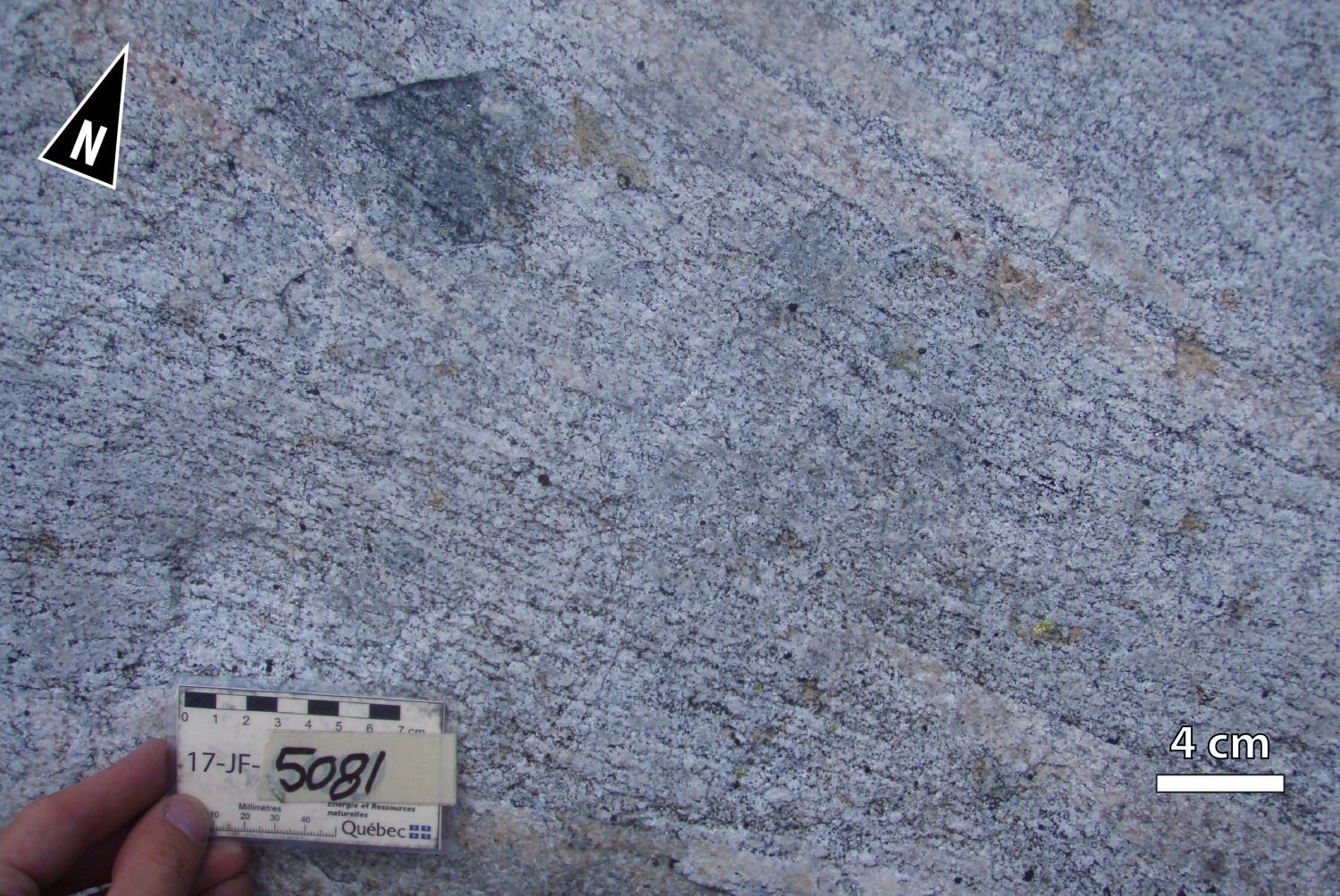 This facies consists of a foliated, homogeneous light grey tonalite. This unit is fine to medium grained and contains 5 to 15% ferromagnesian minerals (biotite ± magnetite ± hornblende). This unit, unlike the one described above, is not a gneissic. Within the tonalitic facies, there are 5 to 25% bands of white hornblende granite and hololeucocratic whitish to pinkish granite in sharp and/or diffuse contact. Some sharp and continuous bands are interpreted as early transposed injections, while those that are millimetric to centimetric, diffuse and discontinuous are instead interpreted as mobilisate. In thin section, tonalite is usually well recrystallized. Typical ferromagnesian minerals are biotite and hornblende. They are disseminated in the matrix and form, in places, continuous or discontinuous millimetric laminae. Within a single thin section, some bands are richer in biotite and others in hornblende. Plagioclase crystals, on the other hand, are locally saussuritized. Accessory minerals observed are zircon, apatite, allanite and sphene.
This facies consists of a foliated, homogeneous light grey tonalite. This unit is fine to medium grained and contains 5 to 15% ferromagnesian minerals (biotite ± magnetite ± hornblende). This unit, unlike the one described above, is not a gneissic. Within the tonalitic facies, there are 5 to 25% bands of white hornblende granite and hololeucocratic whitish to pinkish granite in sharp and/or diffuse contact. Some sharp and continuous bands are interpreted as early transposed injections, while those that are millimetric to centimetric, diffuse and discontinuous are instead interpreted as mobilisate. In thin section, tonalite is usually well recrystallized. Typical ferromagnesian minerals are biotite and hornblende. They are disseminated in the matrix and form, in places, continuous or discontinuous millimetric laminae. Within a single thin section, some bands are richer in biotite and others in hornblende. Plagioclase crystals, on the other hand, are locally saussuritized. Accessory minerals observed are zircon, apatite, allanite and sphene.
Heterogeneous and Foliated Granite and Granodiorite
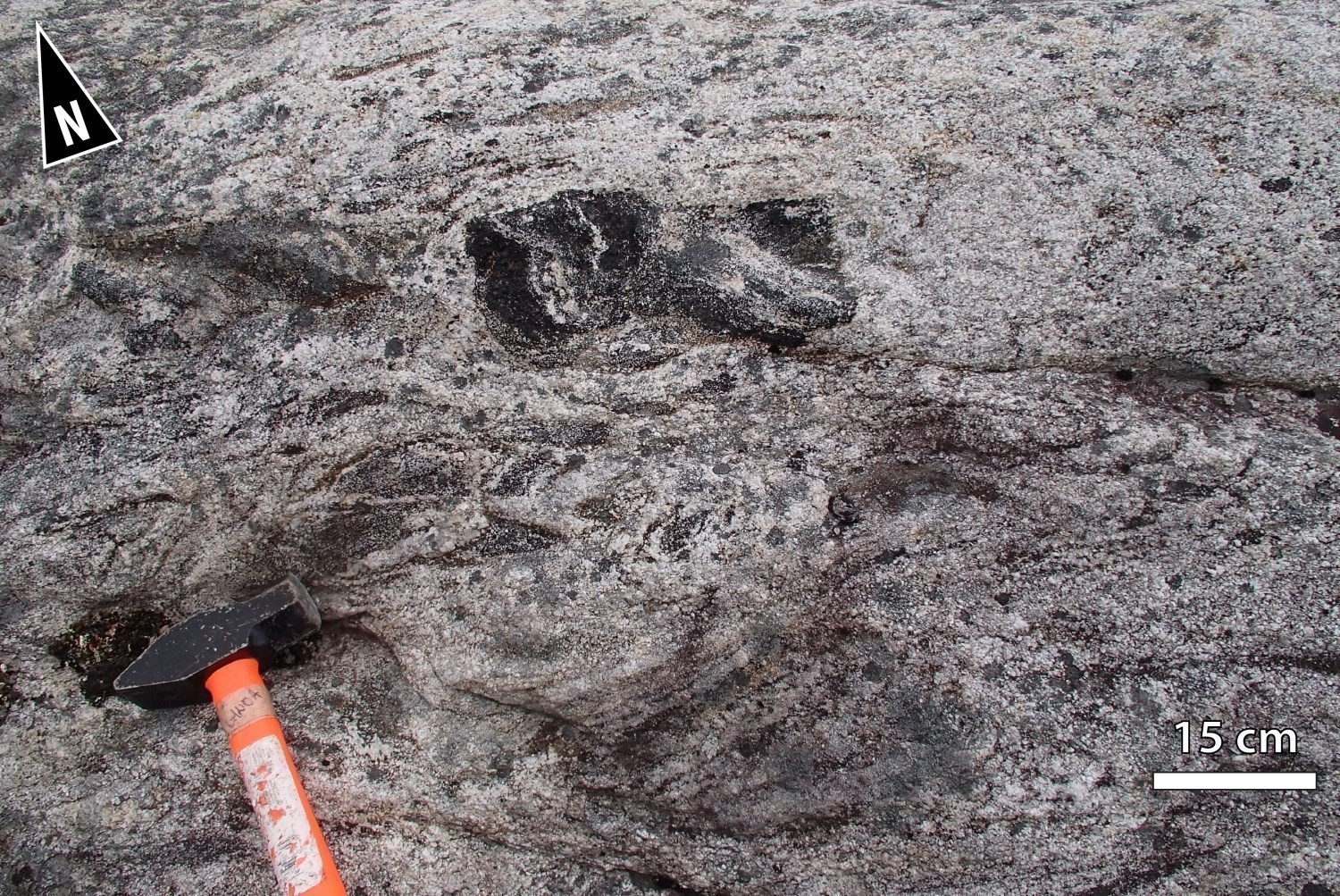 The unit of foliated granite and granodiorite is heterogeneous. It contains 5 to 20% highly assimilated enclaves or relics of felsic intrusive rocks. A beginning of gneissosity marked by segregation of quartzofeldspathic and ferromagnesian minerals can be observed locally, as well as creep textures. This unit is commonly characterized by variation in ferromagnesian minerals and grain size, which contributes to its heterogeneous appearance. Hornblende clusters and phenocrystals are distributed erratically and randomly in the unit. Biotite schlierens are present. This unit could be a heterogeneous diatexite derived from an intrusive protolith
The unit of foliated granite and granodiorite is heterogeneous. It contains 5 to 20% highly assimilated enclaves or relics of felsic intrusive rocks. A beginning of gneissosity marked by segregation of quartzofeldspathic and ferromagnesian minerals can be observed locally, as well as creep textures. This unit is commonly characterized by variation in ferromagnesian minerals and grain size, which contributes to its heterogeneous appearance. Hornblende clusters and phenocrystals are distributed erratically and randomly in the unit. Biotite schlierens are present. This unit could be a heterogeneous diatexite derived from an intrusive protolith
Massive to Weakly Foliated Homogeneous Granite
 Homogeneous granite has a pinkish white alteration patina. It is usually massive to weakly foliated, leucocratic and heterogranular. Biotite and magnetite visible to the naked eye are generally observed. In thin section, traces of hornblende, muscovite, chlorite, epidote, apatite, zircon, as well as myrmekite textures, can be seen.
Homogeneous granite has a pinkish white alteration patina. It is usually massive to weakly foliated, leucocratic and heterogranular. Biotite and magnetite visible to the naked eye are generally observed. In thin section, traces of hornblende, muscovite, chlorite, epidote, apatite, zircon, as well as myrmekite textures, can be seen.
Thickness and Distribution
The Misasque Complex covers an area of 1250 km2 in the Cadieux, Emmanuel and Léran lakes and Bohier Island areas (NTS sheets 33A07 to 33A10 and 23D12). It extends more than 100 km in an ENE-WSW direction, from Léran Lake to Cadieux Lake. The Misasque Complex has a width ranging from 5 to 25 km in a NNW-SSE direction. Its northward extension is limited by the Ribera Pluton and Nikos Suite, two intrusive bodies that mask the contact between the Opinaca and Opatica subprovinces. To the south, it is in contact with the Upper Eastmain Greenstone Belt, Digne Pluton and Wahemen Suite.
Dating
Three samples from the Misasque Complex were dated. The spread of the Mesoarchean to Neoarchean ages demonstrates the existence of several generations of zircons and reflects the complexity of this unit, which contains several phases in diffuse contact.
The first sample, 16-FM-2705, is located in the centre of the complex in sheet 33A09. It is described as a foliated biotite-hornblende-magnetite tonalite. U-Pb analyses gave two age categories for zircons. The oldest is 2822 ±5 Ma and the youngest is 2695 ±8 Ma. The best estimate for the age of magmatic crystallization of the tonalite is 2695 ±8 Ma. Zircons dated to 2822 ±8 Ma would be inherited from an underlying old basement. A rim with low Th/U ratio also yielded an age of 2622 ±16 Ma and would represent the age of a metamorphic event (Davis and Sutcliffe, 2018).
The second sample, 18-FM-2083, also corresponds to a foliated biotite-magnetite tonalite that contains numerous centimetric straight-lined bands of pink granite and sparse diorite enclaves. U-Pb analyses on zircons indicate a magmatic population of varying ages around 2790 Ma, but with older grains up to 3024 Ma (Davis, personal communication, 2019).
Finally, sample 18-FM-2085, is described as a weakly foliated biotite-titanite-epidote tonalite. Tonalite contains highly assimilated biotite schlierens, enclaves and/or restites of tonalite and/or quartz diorite. Gabbro enclaves are also found in tonalite. In this sample, zircons define a uniform age population of 2795 ±5 Ma, but metamorphic overgrowth around two ages, 2683 Ma and 2650 Ma.
| Isotopic System | Mineral | Crystallization Age (Ma) | (+) | (-) | Inherited Age (Ma) | (+) | (-) | Metamorphic Age (Ma) | (+) | (-) | Reference(s) |
| U-Pb | Zircon | 2695 | 8 | 8 | 2822 | 5 | 5 | 2622 | 16 | 16 | Davis and Sutcliffe, 2018 |
| U-Pb | Zircon | 2790 (preliminary age) | – | – | 3024 (preliminary age) | – | – | – | – | – | Davis, personal communication, 2019 |
| U-Pb | Zircon | 2795 (preliminary age) | 5 | 5 | – | – | – |
2683 2650 (preliminary ages) |
11 10 |
11 10 |
Davis, personal communication, 2019 |
Stratigraphic Relationship(s)
The Digne Pluton (2814 ±7 Ma, Davis, personal communication, 2019) seems to intrude into the oldest phases of the Misasque Complex. However, since the Misasque Complex is polyphase, it also contains younger intrusive phases emplaced after the Digne Pluton. Although magmatic crystallization ages (U-Pb on zircons) obtained in homogeneous tonalites of the Misasque Complex are younger than those of the Digne Pluton, inherited ages (3024 Ma and 2822 Ma) and the presence of undated gneissic units in the Misasque Complex suggest that early phases of the Misasque Complex might be earlier than the emplacement of the Digne Pluton.
Volcanics of the Dolent Formation (2751 ±5 Ma, preliminary age, Davis, personal communication, 2019) and the Laguiche Complex unconformably overlie the Misasque Complex. Finally, several Neoarchean intrusive phases clearly cut the complex: Macleod Batholith, Cadieux Suite, Ribera Pluton, Nikos Suite and Wahemen Suite.
Paleontology
Does not apply.
References
| Author(s) | Title | Year of Publication | Hyperlink (EXAMINE or Other) |
|---|---|---|---|
| BEAUCHAMP, A.-M. – MASSEI, F. – DAOUDENE, Y. | Géologie de la région de l’île Bohier, au contact entre les sous-provinces d’Opatica, d’Opinaca et le bassin d’Otish, au nord de Mistissini, Eeyou Istchee Baie-James, Québec, Canada. MERN. BG 2018-02. | 2018 | BG 2018-02 |
| BEAUCHAMP, A.-M. | Géologie et potentiel minéral de la région du lac Cadieux, sous-provinces d’Opatica et d’Opinaca, Eeyou-Istchee Baie-James, Québec. MERN. BG 2109-02. | 2019 | BG 2019-02 |
| DAVIS, D.W., SUTCLIFFE, C.N. | U-Pb Geochronology of Zircon and Monazite by LA-ICPMS in samples from northern Quebec. UNIVERSITY OF TORONTO, 54 pages. | 2018 | MB 2018-18 |
| FROST, B.R. – BARNES, C.G. – COLLINS, W.J. – ARCULUS, R.J. – ELLIS, D.J. – FROST, C.D. | A geochemical classification for granitic rocks. Journal of Petrology; volume 42, pages 2033-2048. | 2001 | Source |
| HOQC, M. | Géologie de la région des lacs Campan et Cadieux, territoire-du-Nouveau-Québec. Ministère de l’Énergie et des Ressources, Québec; ET 83-05, 188 pages, 4 plans. | 1985 | ET 83-05 |
| MCDONOUGH, W.F. – SUN, S.S. | The composition of the earth. Chemical Geology; volume 120, pages 223–253. | 1995 | Source |
| PALME, H. – O’NEILL, H.S.C | Cosmochemical estimates of mantle composition. In Treatise on Geochemistry. (Holland, H.D. and Turrekian, K.K. editors), Elsevier, Amsterdam, The Netherlands; volume 2, pages 1–38. | 2004 | Source |
| PEARCE, J.A. – HARRIS, N.W. – TINDLE, A.G. | Trace element discrimination diagrams for the tectonic interpretation of granitic rocks. Journal of Petrology 25, 956:983. | 1984 | Source |
| TALLA TAKAM, F. – BEAUCHAMP, A.-M. – MASSEI, F. | Géologie de la région des lacs Léran et Emmanuel. Ministère de l’Énergie et des Ressources naturelles, Québec. | In preparation | – |

